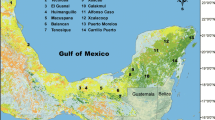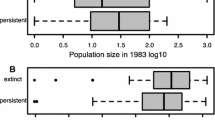Abstract
We made a comparison between life history and reproductive characteristics of a group of Dutch rare (30) and common (105) plant species, all dicotyledonous and insect-visited forbs. The traits life span, clonality, breeding system, seed production, seed dispersal, and soil seed bank longevity are considered. All trait values have been ranked according to their possible effect on the vulnerability of a species for extinction, where low values indicate a low risk and high values a high risk for a species. Rare and common plants differed significantly in four traits: seed production, breeding system, seed bank longevity and clonality. The discriminant analysis showed that 79% of the 135 species was correctly classified in the group they presently belong to. Especially species that are rare now but were much more common 50–100 years ago were classified as being common species, pointing at the detrimental effect of habitat loss these species encountered at which they have not yet been able to adapted to. The data set include eight hemiparasitic plant species (familyOrobanchaceae), of which six are endangered in The Netherlands and two more common. Both rare and common hemiparasites scored high traits values, indicating that they are vulnerable for extinction. The hemiparasites had several characteristics in common: they are all annuals or biennials that have no means of clonal reproduction. They all have non-clustered, zygomorphic flowers that produce nectar and have a precise pollen presentation and are mainly visited by (bumble) bees. Mean life span was significantly shorter in the eight hemiparasiticOrobanchaceae than in the non-hemiparasiticScrophulariaceae used for comparison (4 species). Overall, we concluded that hemiparasitic plants have a special combination of life history traits which makes them vulnerable for local and regional extinction.
Similar content being viewed by others
References
Aizen M., Aizen L. Ashworth L. &Galetto L. (2002): Reproductive success in fragmented habitats: do compatibility systems and pollination specialization matter?J. Veg. Sci. 13: 885–892.
Allen-Wardell G., Bernhardt P., Bitner R., Burquez A., Buchmann S., Cane J., Cox P.A., Dalton V., Feisinger P., Ingram M., Inouye D., Jones C.E., Kennedy K., Kevan P., Koopowitz H., Medellin R., Medellin-Morales S., Nabhan G.P., Kavlik B., Tepedino V., Torchio P. &Walker S. (1998): The potential consequences of pollinator declines on the conservation of biodiversity and stability of food crop yields.Conservation Biol. 12: 8–17.
Bakker J. P., Poschlod P., Strijkstra R.J., Bekker R.M. &Thompson K. (1996): Seed banks and seed dispersal: important topics in restoration ecology.Acta Bot. Neerl. 45: 461–490.
Bakker J. P. &Berendse F. (1999): Constraints in the restoration of ecological diversity in grassland and heath land communities.Trends Ecol. Evol. 14: 63–67.
Bekker R. M., Bakker J. P., Grandin U., Kalamees R., Milberg P., Poschlod P., Thompson K. &Willems J. H. (1998a): Seed size, shape and vertical distribution in the soil: Indicators of seed longevity.Funct. Ecol. 12: 834–842.
Bekker R. M., Schaminée J.H.J., Bakker J.P. &Thompson K. (1998b): Seed bank characteristics of Dutch plant communities.Acta Bot. Neerl. 47: 15–26.
Bond W. (1994): Do mutualisms matter? Assessing the impact of pollinator and disperser disruption on plant extinction.Philos. Trans., Ser. B 344: 83–90.
Bonn S. &Poschlod P. (1998):Ausbreitungsbiologie der Pflanzen Mitteleuropas. Quelle und Meyer Verlag, Wiesbaden.
Bouman F., Boesewinkel D., Bregman R., Devente N. &Oostermeijer G. (2000):Verspreiding van zaden (Seed dispersal). KNNV Uitgeverij, Utrecht.
CBS (1987):Botanisch basisregister (Botanical statistics). Centraal Bureau voor de Statistiek. Leiden.
Chittka L. &Schürkens S. (2001): Successful invasion of a floral market.Nature 411: 653.
Coombe D.E. (1956): Biological flora of the British Isles:Impatiens parviflora DC.J. Ecol. 44: 701–713.
de Kroon H. &van Groenendael J. M. (1997):The ecology and evolution of clonal plants. Backhuys Publishers, Leiden.
Eriksen B., Molau U. &Svensson M. (1993): Reproductive strategies in two arcticPedicularis species (Scrophulariaceae).Ecography 16: 154–166.
Fenner M. (1992):Seeds. The ecology of regeneration in plant communities. CAB International, Wallingford.
Fossel A. (1974): Die Bienenweide der Ostalpen, dargestelt am Beispiel des steirischen Ennstales.Mitt. Naturwiss. Vereins Steiermark 104: 87–118.
Fossel A. (1977): Raffinierter Nektarraub beim klappertopf (Rhinanthus sp.).Bienenvater 1: 1–4.
Gomez J.M. (2002): Self-pollination inEuphrasia wilkommii Freyn (Scrophulariaceae), an endemic species from the alpine of the Sierra Nevada (Spain).Pl. Syst. Evol. 232: 63–71.
Hartl D. (1974):Scrophulariaceae. In:Hegi G.,Illustrierte Flora von Mittel-Europa 6. Carl Hanser Verlag, München, pp. 451–469.
Huenneke L.F. (1991): Ecological implications of genetic variation in plant populations. In:Falk D.A. &Holsinger K.E. (eds.),Genetics and conservation of rare plants, Oxford University Press, New York, pp. 31–44.
IUCN (1994).IUCN Red List Categories. Prepared by the IUCN Species Survival Commission. IUCN, Gland.
Karrenberg S. &Jensen K. (2000): Effects of pollination and pollen source on the seed set ofPedicularis palustris.Folia Geobot. 35: 191–202.
Kearns C.A., Inouye D.W. &Waser N. M. (1998): Endangered mutualisms: the conservation of plant-pollinator interactions.Annual Rev. Ecol. Syst. 29: 83–112.
Klimeš L. &Klimešová J. (1999): CLO-PLA 2 — A database of clonal plants in central Europe.Pl. Ecol. 141: 9–19.
Kremen C. &Ricketts T. (2000): Global perspectives on pollination disruption.Conservation Biol. 14: 1226–1228.
Kwak M.M. (1977): Pollination ecology of five hemiparasitic, large-floweredRhinanthoideae with special reference to the pollination behaviour of nectar-thieving, short-tongued bumblebees.Acta Bot. Neerl. 26: 97–017.
Kwak M.M. (1979): Effects of bumblebee visits on the seed set ofPedicularis, Rhinanthus andMelampyrum (Scrophulariaceae) in the Netherlands.Acta Bot. Neerl. 28: 177–195.
Kwak M.M. (1980). The pollination value of honeybees to the bumblebee plantRhinanthus.Acta Bot. Neerl. 29: 597–603.
Kwak M.M. (1988): Pollination ecology and seedset in the rare annual speciesMelampyrum arvense L. (Scrophulariaceae).Acta Bot. Neerl. 37: 153–163.
Kwak M.M. &Jennersten O. (1986): The significance of pollination time and frequency and of purity of pollen loads for the seed set inRhinanthus angustifolius (Scrophulariaceae) andViscaria vulgaris (Caryophyllaceae).Oecologia (Berlin) 70: 502–507.
Kwak M.M. &Jennersten O. (1991): Bumblebee visitation and seed set inMelampyrum pratense andViscaria vulgaris: heterospecific pollen and pollen limitation.Oecologia (Berlin) 86: 99–104.
Kwak M.M. &Bergman P. (1996): Early flowers ofBartsia alpina (Scophulariaceae) and the visitation by bumblebees.Acta Bot. Neerl. 45: 355–366.
Kwak M.M. &Tieleman I. (2000):Het Hommelleven (The life of bumblebees). KNNV uitgeverij, Utrecht.
Lande R. (1998): Anthropogenic, ecological and genetic factors in extinction and conservation.Res. Populat. Ecol. 40: 259–269.
Macior L.W. (1982): Plant community and pollinator dynamics in the evolution of pollination mechanisms inPedicularis (Scrophulariaceae). In:Amstrong J.A., Powell J.M. &Richards A.J. (eds.),Pollination and evolution, Royal Botanic Gardens, Sydney.
Macior L.W. (1986): Floral resource sharing by bumblebees and hummingbirds inPedicularis (Scrophulariaceae) pollination.Bull. Torrey Bot. Club 113: 101–109.
Macior L.W. (1993): Pollination ecology ofPedicularis palustris L. (Scrophulariaceae) in North America.Pl. Spec. Biol. 8: 35–44.
Macior L.W. (1995): Pollination ecology ofPedicularis in the Teton Mountain Region.Pl. Spec. Biol. 10: 77–82.
Olesen J.M. &Jain S.K. (1994): Fragmented populations and their lost interactions. In:Loeschcke V., Tomiuk J. &Jain S.K. (eds.),Conservation genetics, Birkhäuser Verlag, Basel, pp. 417–426.
Perrins J., Fitter A. &Williamson M. (1993): Population biology and rates of invasion of 3 introducedImpatiens species in the British-isles.J. Biogeogr. 20: 33–44.
Philipp M., Woodell S.R.J., Bocher J. &Mattsson O. (1996): Reproductive biology of four species ofPedicularis (Scrophulariaceae) in West Greenland.Arctic Alpine Res. 28: 403–413.
Proctor M., Yeo P. &Lack A. (1996):The natural history of pollination. Harper Collins Publishers, London.
Rasmont P. (1988):Monographie ecologique et zoogeographique des bourdons de France et de Belgique (Hymenoptera, Apidae, Bombinae). PhD. Thesis, University of Gembloux, Gembloux.
Rathcke B. (1983): Competition and facilitation among plants for pollination. In:Real L. (ed.),Pollination biology, Academic Press, New York, pp. 305–329.
Rathcke B.J. &Jules E.S. (1993): Habitat fragmentation and plant-pollinator interactions.Curr. Sci. 65: 273–277.
Rocio J., Pastor J. &Immaculada F. (1996): Studies of fruits, seeds and pollen morphology ofPedicularis sylvatica L. subsp.lusitanica (Hoffmanns andLink)Cout. (Scrophulariaceae).Anales Jard. Bot. Madrid 54: 312–318.
Rosenthal G. &Fink S. (1996):Pedicularis palustris L. in the Bremen area: Distribution, ecology, and causes of its decline.Abh. Naturwiss. Vereine Bremen 43: 429–447.
Salisbury E. J. (1942):The reproductive capacity of plants. Studies in quantitative biology. G. Bells and Son, Ltd, London.
Šerá B. &Šerý M. (2004): Number and weight of seeds and reproductive strategies of herbaceous plants.Folia Geobot. 39: 27–40.
SPSS (2003):SPSS Base 12.0 user’s guide. SPSS Inc. Chicago.
Strykstra R.J., Verweij G.L. &Bakker J.P. (1997): Seed dispersal by mowing machinery in a Dutch brook valley system.Acta Bot. Neerl. 46: 387–401.
Strykstra R.J., Bekker R.M. &van Andel J. (2002): Dispersal and life span spectra in plant communities: a key to safe site dynamics, species coexistence and conservation.Ecography 25: 145–160.
Tamis W.L.M., van der Meijden R., Runhaar J, Bekker R.M., Ozinga W., Odi B. &Hoste I. (2004): Standaardlijst van de Nederlandse flora 2003 (Standard list of the flora of the Netherlands 2003).Gorteria 30: 101–195.
Thompson K., Bakker J.P. &Bekker R.M. (1997):Soil seed banks of NW Europe: methodology, density and longevity. Cambridge University Press, Cambridge.
Turnbull L.A., Crawley M.J. &Rees M. (1999): Are plant populations seed-limited? A review of seed sowing experiments.Oikos 88: 225–238.
van der Meijden R., Odi B., Groen C.L.G., Witte J.P.M. &Bal D. (2000): Bedreigde en kwetsbare vaatplanten in Nederland, Basisrapport met voorstel voor de Rode Lijst (Endangered vascular plants in The Netherlands, with proposal for the Red List).Gorteria 26: 85–208.
Weller S.G. (1994): The relationship of rarity to plant reproductive biology. In:Bowles M.L. &Whelan C.J. (eds.),Restoration of endangered species: conceptual issues, planning, and implementation, Cambridge University Press, Cambridge, pp. 90–117.
Williams P.H. (1989): Why are there so many bumble bees at Dungeness?Bot. J. Linn. Soc. 101: 31–44.
Author information
Authors and Affiliations
Rights and permissions
About this article
Cite this article
Bekker, R.M., Kwak, M.M. Life history traits as predictors of plant rarity, with particular reference to hemiparasiticOrobanchaceae . Folia Geobot 40, 231–242 (2005). https://doi.org/10.1007/BF02803237
Received:
Revised:
Accepted:
Issue Date:
DOI: https://doi.org/10.1007/BF02803237




